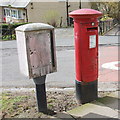1
Gregness Gardens, Aberdeen
The unusual "X" shaped junction that connects the parallel roads of Girdleness Road and Kirkhill Road.
Image: © Bill Harrison
Taken: 6 Oct 2012
0.09 miles
2
Edward VIII pillar box...
...at the junction of Gregness Gardens and Girdleness Road. One of only two to be found in Aberdeen and 136 nationwide.
Image: © Bill Harrison
Taken: 16 Apr 2016
0.09 miles
3
Hillside housing, Girdleness Road, Aberdeen
Torry is built on a hill, and a number of south-facing blocks of flats rise up in tiers...
Image: © Bill Harrison
Taken: 6 Oct 2012
0.09 miles
4
Balnagask Road, Torry
Image: © JThomas
Taken: 18 Jul 2014
0.10 miles
5
Tullos Primary School
The classroom blinds add a nice bit of colour to this iconic 1930s art deco building, but the rusting metal and crumbling mortar are concerning... B-listed: http://www.britishlistedbuildings.co.uk/sc-49995-tullos-primary-school-girdleness-road-#.VxNisaT2amQ .
Image: © Bill Harrison
Taken: 16 Apr 2016
0.10 miles
6
Tullos Primary School
One of Aberdeen's most striking 1930s buildings (although it did not open until 1950). It was meant to have a pitched roof, but the War intervened and a flat roof was installed. Its south-facing and light and airy construction, with "fold back" glazed panels (now sadly no longer functional) must have been truly ground-breaking.
B-listed: http://www.britishlistedbuildings.co.uk/sc-49995-tullos-primary-school-girdleness-road-
Image: © Bill Harrison
Taken: 6 Oct 2012
0.12 miles
7
Frontage of Tullos Primary School
Image: © Ewen Rennie
Taken: 2 Apr 2010
0.13 miles
8
Under the Bridge
Motor vehicles are now blocked from Ladywell Place (under the bridge). The bridge carries the main Aberdeen-Dundee railway line.
Image: © Bill Harrison
Taken: 6 Oct 2012
0.13 miles
9
Rear of Tullos Primary School
Image: © Ewen Rennie
Taken: 2 Apr 2010
0.14 miles
10
Early morning sea haar in Torry housing estate.
On the east coast of Scotland a sea fog, known locally as Haar, often plagues the local residents and ruins what would otherwise be a fine day. It most commonly occurs between April and September, on or near the east coast or in the Northern Isles.
It does not usually penetrate far inland, but can filter through valleys like the Great Glen and the Central Lowlands as far as Glasgow. Haar forms when a parcel of warm air passes over the cold North Sea. The warm air at the bottom of the parcel is cooled by the cold air below, until it can no longer 'hold' the moisture that was previously contained within. Therefore, it releases some of the moisture in the form of liquid water through condensation. Add an onshore component like a wind of 5-20mph, and the cooling in the bottom of the warm parcel of air is spread upwards and generates a fog like Haar.
Image: © Colin Kinnear
Taken: 3 Feb 2011
0.15 miles











